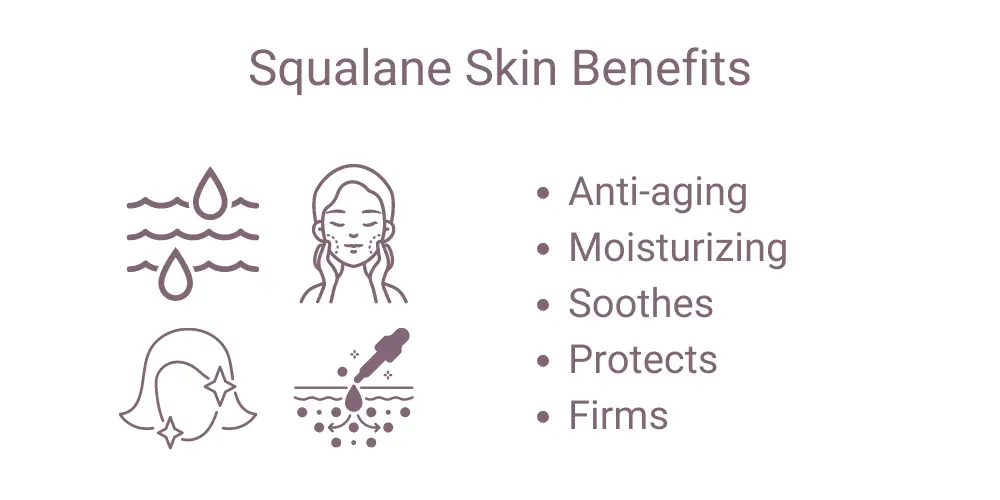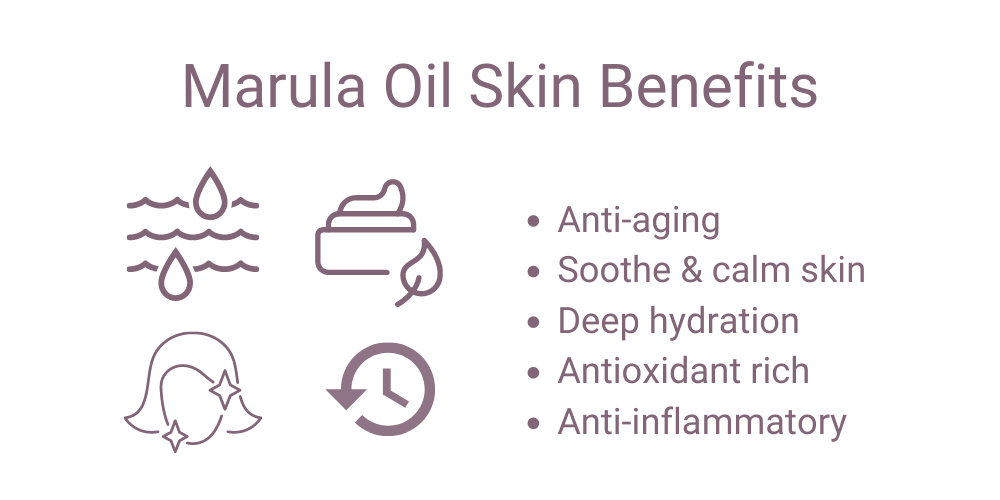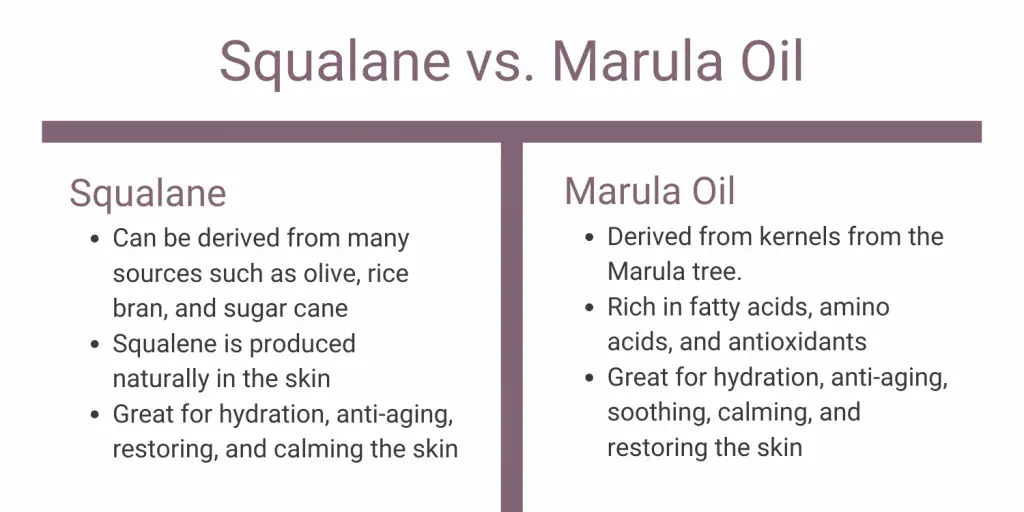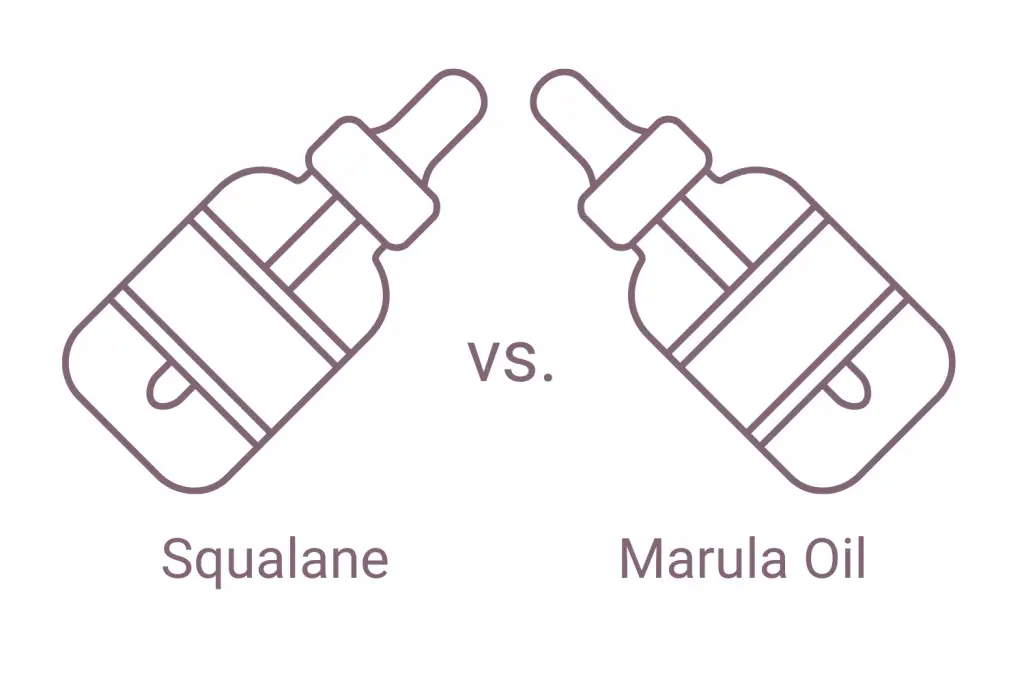When it comes to keeping the skin looking youthful, plump, and healthy, grabbing a facial oil that can replenish what skin loses with age is an essential part of the process.
This post may contain affiliate links. Read the full disclosure here
Some people steer clear of facial oils because of the fear that they will make the skin, well, oily and cause breakouts.
However, the best facial oils on the market can actually penetrate the skin like a lotion and leave behind a beautiful glow and healthier skin.
Two great examples of this are squalane and marula oil. These natural oils offer many of the same anti-aging and moisturizing benefits but they have notable differences as well.
What is Squalane?
Oftentimes confused with the natural lipid our skin naturally produces, called squalene, squalane with an ‘a’ is a stabilized version of the oil that is created by hydrogeneration. When stabilized, squalane can last far longer than the naturally occurring version, therefore making it ideal for skin care products as an ingredient or to be used totally on its own.
Squalane is basically a miracle oil when it comes to the skin. When squalane oil first hit the beauty market, the methods of harvesting were unethical, to say the least. Squalane naturally occurs in the livers of sharks which, of course, can open the door to questionable harvesting methods.
Thankfully, most brands in the United States have strayed away from the old-school way of obtaining squalane and have, instead, turned to natural sources like olives and rice bran. This is great news for consumers that care about where their beauty products come from.
Squalane Benefits
While squalene is a natural lipid found in sebum and a major building block when it comes to glowing skin, it, unfortunately, doesn’t hang around forever.
After around 30 years old, our skin takes a steep nosedive in the hydration department, which can speed up the aging process.
- Moisturizes
- Softens
- Helps protect from sun damage
- Reduces the appearance of fine lines and wrinkles
- Soothes
- Firms
Squalane replenishes the skin by improving elasticity and boosting moisture without clogging pores or causing breakouts.
When it comes to how it will change your skin, squalane is a key ingredient in skincare products that aim to reduce fine lines and wrinkles, eliminate the severity of scars, help with the appearance of UV damage, and essentially reverse the clock of your skin.

Other Squalane comparison articles you might like
- Squalane vs. Argan Oil
- Squalane vs. Rosehip Oil
- Squalane vs. Hyaluronic Acid
- Squalane vs. Jojoba Oil
- Squalane vs. Retinol
What is Marula Oil?
Derived from the kernels from the fruit of the ancient Marula tree in southern Africa, Marula oil is packed full of antioxidants, fatty acids, and amino acids.
Previously on the brink of extinction, the marula tree was extremely rare, though it is now cultivated, making it easier to harvest. The other parts of the tree, like the branches, leaves, and bark are often used medicinally. The oil has a light and pleasant nutty smell and a beautifully delicate golden color.
Marula Oil Benefits
Found in products for hair and nails, marula oil is an exceptional ingredient when it comes to skincare. With an impressive profile, the oil is hydrating and moisturizing while also being protective against free radicals and damage caused by UV rays.
Since free radicals include everything from pollution in the air to excessive stress, it is amazing that marula oil can create a protective-like shield over your skin.
- Moisturizes
- Softens
- Helps protect from sun damage
- Reduces the appearance of fine lines and wrinkles
- Soothes and calmes
Despite being an oil, it is ideal for inflamed skin caused by a pesky acne breakout since it is super lightweight. The antimicrobial aspects of the oil also help to fight off acne-causing bacteria too.
However, it is important to keep in mind that marula oil is considered comedogenic. This means that it is a product that will likely clog the pores, causing congestion that can lead to breakouts. Rich with oleic and linoleic fatty acids, marula oil makes this feathery light oil and a heavy hitter when it comes to softening dry skin.
Studies have found that the antioxidants, including vitamin C and vitamin E, found in marula oil can help slow down the degradation of healthy skin proteins like collagen and elastin.

Other marula oil comparison articles you might like
Squalane vs Marula Oil
On the surface, marula oil and squalane seem to offer the same benefits to the skin. They both provide moisture, combat fine lines, and wrinkles, and help the skin bounce back to a more youthful state.
Overall, either of the oils can be a game-changer when it comes to your skincare routine. Both oils work well with a spectrum of skin types which can be hard to find.
They are both super lightweight, so the absorption is quick and efficient. Both oils really target signs of aging to help restore your natural glow and supple texture.
However, there are clear differences between squalane and marula oil that may make a skincare lover choose one over the other.

Squalane and Marula Oil Differences
Squalane is essentially designed to replenish what our skin already produces naturally (squalene), which means it is a pro at hydration and boosting moisture without causing acne. This is especially beneficial if you are managing a skin condition that disrupts the surface layer of the skin that helps lock in moisture like eczema or psoriasis. Moreover, squalane can be used on acne-prone or oily skin as well.
On the flip side, marula oil is the gold standard when it comes to facial oils for mature skin. As we age, our skin loses its elasticity as well as its hydration, which leads to wrinkles and signs of aging.
The naturally occurring antioxidants and fatty acids in marula oil help to protect collagen and elastin, which are key to youthful skin.
Again, marula oil is lightweight, so it absorbs quickly while still moisturizing the skin and leaving behind a smooth and natural glow.
Squalane and Marula Oil Together
While there is nothing totally wrong with using marula oil and squalane together, the combination may not be suitable for all skin types. Since marula oil really targets dry to very dry or aging skin types, it may be overly moisturizing for someone with super oily skin.
Marula oil can also clog pores, which can be an issue for oily skin types or those who are battling with acne. Therefore, using it along with squalane might be an unnecessary overload for the skin.
If you have very dry skin, throwing squalane in the mix with marula oil may actually work a bit better but could also turn out to be too much of a good thing. However, for a person that is interested in hydration and improving the overall health of their skin, the combination of the two oils could offer that.
Once you’ve decided on the oil that will work best for you, you may be wondering how to incorporate it into your skincare routine. If you are new to facial oils, don’t worry!
Many start out using facial oils in a less than effective order. However, the best way to use either squalane or marula oil is to apply it as the very last step. This means after you’ve washed, toned, treated, and moisturized your skin, you should apply the oil.
Remember, a little goes a long way so just 1 to 3 drops warmed up in your hands and pressed into your skin is plenty.
Bottom Line
To summarize, squalane is a lab-created version of the naturally occurring squalene. It has incredible anti-aging, collagen-boosting, super-hydrating properties that won’t clog the pores.
If you’re struggling with eczema or psoriasis, the anti-inflammatory properties make squalane a dream oil to use.
Marula oil, derived from the southern African marula tree, is lightweight and nutty. Packed full of antioxidants and fatty acids, marula oil is perfect for dry to very dry or mature skin.
Since it is so moisturizing, marula oil should be avoided by those with natural oil or acne-prone skin types as it can clog pores and cause bigger skin issues.
Either oil should be used as the last step to your skincare routine, after cleansing, toning, and moisturizing. Since they are facial oils, they are able to seal in all of the previous skincare steps of your routine, helping all of your products penetrate into the skin.
Finally, the products can be used together or separately. However, because marula oil isn’t ideal for oily skin, it might not create the desired effect for everyone.





